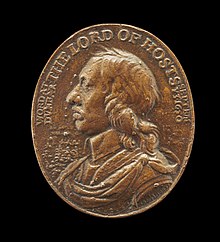This is an old revision of this page, as edited by TheBestEditorInEngland (talk | contribs) at 09:47, 3 January 2025 (Sat in a sandbox for far too long, creating an article with the small amount I have already done although there is lots of room for expansion an the topic is notable for an article.). The present address (URL) is a permanent link to this revision, which may differ significantly from the current revision.
Revision as of 09:47, 3 January 2025 by TheBestEditorInEngland (talk | contribs) (Sat in a sandbox for far too long, creating an article with the small amount I have already done although there is lots of room for expansion an the topic is notable for an article.)(diff) ← Previous revision | Latest revision (diff) | Newer revision → (diff) Campaign medal awarded for participation in the 1650 Battle of DunbarAward
| Dunbar Medal | |
|---|---|
 The obverse of a silver Dunbar Medal The obverse of a silver Dunbar Medal | |
| Type | Campaign Medal |
| Awarded for | Campaign service |
| Presented by | Commonwealth of England |
| Eligibility | All officers and other ranks of the New Model Army who participated in the Battle of Dunbar on 3rd September 1650 |
| Campaign(s) | Battle of Dunbar (3 September 1650) |
| Clasps | None |
| Established | 1650 |
| First awarded | 1651 |
The Dunbar Medal was an English campaign medal issued by the Commonwealth of England. It was sanctioned by Parliament in 1650 to be awarded in Gold to officers and in Silver to other ranks of the New Model Army who participated in the Battle of Dunbar on 3 September 1650. The Dunbar Medal is thought by historians and numismatists to be the first ever military medal to be eligible to every man present in a campaign or engagement, irrespective of rank. It was worn by a cord or chain around the neck.

Citations
References
- Lessen, Marvin (1981). "THE CROMWELL DUNBAR MEDALS BY SIMON" (PDF). British Numismatic Society. Retrieved 6 February 2021.